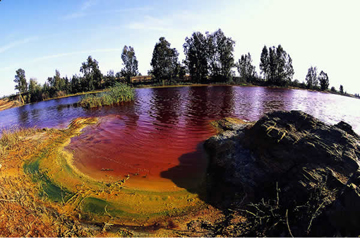 |
|
Rio Tinto's acidic waters contain heavy metal concentrations
at much higher levels than typical fresh water.
Photo credit: J.L. De Lope, J.M. Sanchez
|
|
 |
|
| Deep-sea hydrothermal vent. Photo credit: OAR/National Undersea Research Program (NURP); NOAA |
|
 |
|
| Euglena mutabilis, a microbe collected from Spain's Rio Tinto. Photo credit: Linda Amaral-Zettler, David Patterson |
|
|
|
|
|
Since living conditions in other parts of our solar system are proving to be extreme, scientists searching for extraterrestrial life need to know something about creatures that can survive such conditions. Fortunately, they can study Earth's extremophiles " microbes that thrive in conditions that would kill most life forms.
This summer, in hopes of aiding the search for life on other planets and moons, scientists in the MBL's Bay Paul Center for Comparative Molecular Biology and Evolution are analyzing acid- and metal-loving extremophiles collected from the Rio Tinto, an ancient, acidic river in Spain, as well as microbes found in the super-hot conditions of deep-sea hydrothermal vents.
The research, funded by NASA, is designed to provide clues about the genetics and physiology of these specially adapted organisms. Such information is critical to helping astrobiologists hypothesize what kind of extraterrestrial life they might expect to find and how best to search for it.
|